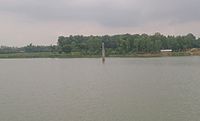Dibar Dighi
| Dibar Dighi | |
|---|---|
| Native name Bengali: দ্বিবর দিঘি | |
 view of Dibor Dighi | |
| Location | Patnitala Upazila Naogaon District, Bangladesh |
Dibar Dighi (Bengali: দ্বিবর দিঘি) is a tank in Patnitala Upazila, Naogaon District, Bangladesh.[1][2][3][4]
History
Dibar Dighi and Kaivarta Stambha Dibar Dighi (pond) with the Kaibvrta stambha (pillar) is located at a village on the northern side of Najipur-Shapahar highway in Patnitala upazila of Noagaon district. The dighi was excavated in the centre of an elevated mound measuring about 100 acres covering an area of 20 acres of land. The octagonal granite pillar known as Kaivarta Stambha stands in the centre of the tank. The apex of the pillar is crown shaped decorated with three inflated circular rings.
Sir Buchanon Hamilton visited the site in 1807-08 and measured the height of the pillar as 10.33 metres. Sir Alexandar Cunninghum visited the site in 1879-80 and reported the pillar’s height as 9.14 metres. According to his report, the length of this pillar’s underground portion was 2.5 to 3 metres, under-water length 4 metres and the length of visible portion over water was estimated as only 3 metres. He also reported that the length between each angle was 4 metres.
Dibar Dighi and Kaivarta Stambha
It can be assumed from these historical evidences that the monument was built as a memorial of the victory of Kaivarta king Dibyak or Dibya in his war against king Mahipala II (1075-1080) of Pala dynasty. The pillar appears to be built by king Dibyak or his successor Rudak or Bhim sometime in the second half of the eleventh century. The name of the village as Dibar may be derived after the name of king Dibyak or Dibya.[4]
See also
References
- ^ Chakrabarti, Dilip K. (1992). Ancient Bangladesh, a study of the archaeologcial sources. Oxford University Press. p. 155.
- ^ Indian Information Series. Vol. 4–5. India: Bureau of Public Information. 1939.
- ^ Maitreẏa, Akshaẏakumāra (1987). The fall of the Pāla Empire. University of North Bengal. p. 44.
- ^ a b Rahman, Kazi Mostafizur (2012). "Dibar Dighi and Kaivarta Stambha". In Islam, Sirajul; Jamal, Ahmed A. (eds.). Banglapedia: National Encyclopedia of Bangladesh (Second ed.). Asiatic Society of Bangladesh.
{{cite book}}: External link in|chapterurl=|chapterurl=ignored (|chapter-url=suggested) (help)

